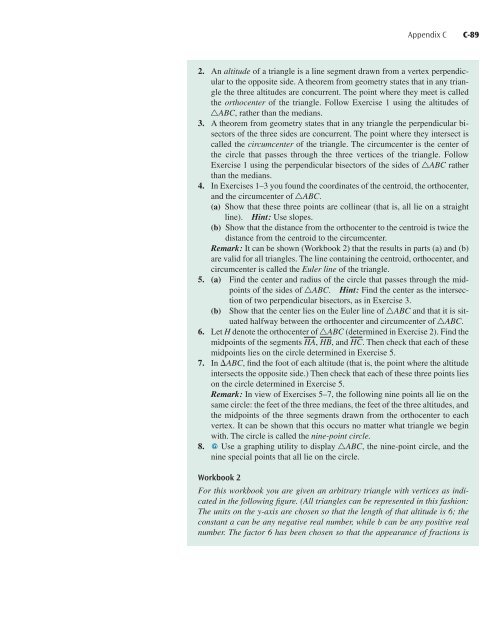You also want an ePaper? Increase the reach of your titles
YUMPU automatically turns print PDFs into web optimized ePapers that Google loves.
Appendix C C-89<br />
2. An altitude of a triangle is a line segment drawn from a vertex perpendicular<br />
to the opposite side. A theorem from geometry states that in any triangle<br />
the three altitudes are concurrent. The point where they meet is called<br />
the orthocenter of the triangle. Follow Exercise 1 using the altitudes of<br />
^ABC, rather than the medians.<br />
3. A theorem from geometry states that in any triangle the perpendicular bisectors<br />
of the three sides are concurrent. The point where they intersect is<br />
called the circumcenter of the triangle. The circumcenter is the center of<br />
the circle that passes through the three vertices of the triangle. Follow<br />
Exercise 1 using the perpendicular bisectors of the sides of ^ABC rather<br />
than the medians.<br />
4. In Exercises 1–3 you found the coordinates of the centroid, the orthocenter,<br />
and the circumcenter of ^ABC.<br />
(a) Show that these three points are collinear (that is, all lie on a straight<br />
line). Hint: Use slopes.<br />
(b) Show that the distance from the orthocenter to the centroid is twice the<br />
distance from the centroid to the circumcenter.<br />
Remark: It can be shown (Workbook 2) that the results in parts (a) and (b)<br />
are valid for all triangles. The line containing the centroid, orthocenter, and<br />
circumcenter is called the Euler line of the triangle.<br />
5. (a) Find the center and radius of the circle that passes through the midpoints<br />
of the sides of ^ABC. Hint: Find the center as the intersection<br />
of two perpendicular bisectors, as in Exercise 3.<br />
(b) Show that the center lies on the Euler line of ^ABC and that it is situated<br />
halfway between the orthocenter and circumcenter of ^ABC.<br />
6. Let H denote the orthocenter of ^ABC (determined in Exercise 2). Find the<br />
midpoints of the segments HA, HB, and HC. Then check that each of these<br />
midpoints lies on the circle determined in Exercise 5.<br />
7. In ¢ABC, find the foot of each altitude (that is, the point where the altitude<br />
intersects the opposite side.) Then check that each of these three points lies<br />
on the circle determined in Exercise 5.<br />
Remark: In view of Exercises 5–7, the following nine points all lie on the<br />
same circle: the feet of the three medians, the feet of the three altitudes, and<br />
the midpoints of the three segments drawn from the orthocenter to each<br />
vertex. It can be shown that this occurs no matter what triangle we begin<br />
with. The circle is called the nine-point circle.<br />
8. Use a graphing utility to display ^ABC, the nine-point circle, and the<br />
nine special points that all lie on the circle.<br />
Workbook 2<br />
For this workbook you are given an arbitrary triangle with vertices as indicated<br />
in the following figure. (All triangles can be represented in this fashion:<br />
The units on the y-axis are chosen so that the length of that altitude is 6; the<br />
constant a can be any negative real number, while b can be any positive real<br />
number. The factor 6 has been chosen so that the appearance of fractions is
















